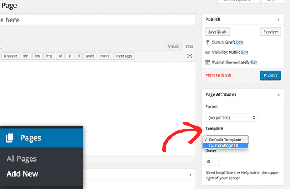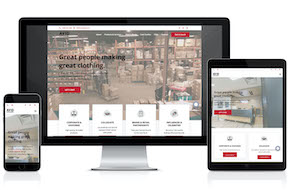
Enjoy the Benefits of a Totally Custom Theme!
Don’t settle for the templates everybody else is using
We’ve talked about the benefits of having your own custom theme built in a blog post before. That was more than two years ago, yet the benefits of a uniquely tailored website still outweigh any potential benefits of the templated ‘customizable’ themes. In this post, we’ll go through each main aspect of a custom theme that will leave you wondering why you ever considered something like a visual builder!
Custom post types (and fields)
One of the biggest benefits of a custom theme is the ability to add custom post types. By default, WordPress comes with the basics: pages and posts. But there’s so much more you can create, especially in custom theme development. Some pre-built themes and plugins add a few new post types – the WooCommerce plugin adds Products as a post type, for example. These can be handy, but they still don’t provide a uniquely tailored solution to your website issues.
When outlining a custom theme, you can specify however many custom post types you want. Are you a photographer who needs to upload new portfolio items? Do you want a separate area to add reviews or testimonials? Have a section on the website you want to populate with your team or staff? Custom post types are able to accomplish all of this.
Sure, you can probably find a plugin to fulfill these needs too. But each plugin you add to your site comes with a whole new bed of code to read that can affect your load speed or other performance aspects. Besides, are these really custom solutions? You’re still stuck with whatever features the developers decide to offer. But when you outline a custom theme, a site developer like Mr. WPress will also work with you to create custom fields for those custom post types. Want to mark when you make a sale on your portfolio item? Want the review you just entered to appear on the testimonials page, but not be featured on the home page? Want to feature an employee of the month? All of these are easily accomplished with custom fields.
Custom widget areas and sidebars
Most customizable themes have only a few widget areas, a left and right sidebar and some footer areas. Like default WordPress, these are good at covering the basics, but so much more is possible in a tailored custom theme. Want a widget area on your homepage, so you can rotate through different featured elements? Want a special area above the menu where you can feature offers in a prominent banner? Mr. WPress can create widget areas to perfectly suit your needs.
Plus, you won’t be stuck with the templated styling of these sidebars either. You can wholly specify where, when, and how you’d like your sidebars or other widget areas to appear. The possibilities are pretty limitless when you’re not choosing from a list of options, but instead writing custom code to accomplish exactly what you’re looking for.
Custom menus
If you’ve ever tried to edit the menu of a customizable theme, you should be very familiar with the restrictions. Trying to create a unique look with the limited array of options is nearly impossible. Not only that, but often the options are glitchy, or don’t even show up. But having a custom theme built eases the whole process tremendously. When you outline your website, the menu and footer will be an important part. And without a prebuilt template, a web developer like Mr. WPress will be able to accomplish the exact look you’re going for with a little bit of lightweight CSS.
This doesn’t only apply to the menu up in your header, either. Want a secondary header menu, a menu down in the footer, a slide-in menu, or a sidebar menu? All of these can be fully custom designed as well, and created in the same spot as normal menus for easy management and edits later down the road. And especially with Mr. WPress, you won’t have to worry about how your menu appears on different devices and screen sizes, since responsive design is at the forefront of our minds.
Custom shortcodes
Custom shortcodes are similar to custom post types, but designed for smaller tasks that you want to implement multiple times throughout your website. A lot of customizable themes come with some built-in shortcodes, but like most everything else in this type of theme, you’re limited to a fairly small list. But when you’re having your own wholly custom theme built, you can specify as many shortcodes as you want. These can start fairly simple, like repeating a button design with varying text and links or displaying a single item from your photo portfolio. But it’s possible to get more complex tasks built into a shortcode too, like a slideshow where you specify the looping speed and which particular images go into the slideshow.
Best of all, these shortcodes make it easy to manipulate your content later down the road without a developer’s help. With a little forwarding thinking, you can create shortcodes to make it possible to create complicated elements with a little bit of text between some brackets. They’re easy to use, easy to learn, and easy to create when you’re having a custom theme built!
Custom plugins
Need something a little more complicated than a shortcode? That’s where custom plugins enter the scene. We’ve talked about the huge benefits of custom plugins before: finely-tuned, lightweight, user-specific counterparts to the bulkier options available on the WordPress repository. When you have a custom plugin built, you know exactly what you’ll be getting, and you can rest assured knowing that it won’t slow down your website with a heavy load of options that you never wanted anyway.
Higher performance
The same principles of custom plugins being better for your website than prebuilt plugins applies to the wider range of websites, too. Customizable themes and visual builders need to include as many options as possible to appease as many people as possible. This inherently weighs down their code, which weighs down your load speed just to support options you may not even need or want. And even with all this weight, it’s often still difficult to build exactly what you’re looking for on your website. You’ll be stuck adding a wide variety of plugins that only slow down your site even more.
But with a custom theme, you go through an outlining process to determine exactly what you need, and then a designer like Mr. WPress will build it for you to your specifications. You get just what you need, with no list of features to scroll through that you’ll never use. But that doesn’t mean your website can’t be customized further by you. Custom widget areas, post types, and shortcodes allow you to rearrange and add or remove content easier than ever.
Need some proof? Just check out the Mr. WPress portfolio for a wide range of high-performing, fully customized sites that our clients loved. Want to get started with your own custom theme? Reach out to Mr. WPress today for a free quote! We’d be delighted to learn how we can help you build the website of your dreams.



